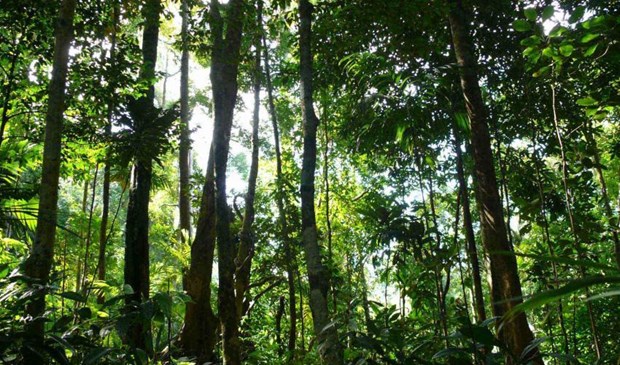Thailand pilots new forestation plan
The Royal Forest Department of Thailand is introducing a new forest plantation model that it says can cut costs while creating more green space.
 A forest of Thailand (Source: www.iucn.org)
A forest of Thailand (Source: www.iucn.org)Bangkok (VNA) – The Royal
Forest Department of Thailand is introducing a new forest plantation model that
it says can cut costs while creating more green space.
The Bangkok Post reported that the plan is part of the government's 20-year national plan to increase the amount of forested area to 55 percent, against the current rate of 30 percent.
The new model was introduced after the department realised its current forestation budget and model was not achieving enough, said Attapon Charoenchansa, director-general of the Forest Department.
The department spent almost 900 million baht (29.2 million USD) on planting trees across 800,000 rai of land in the last fiscal year, at an expense of 10,960 baht per rai (1 rai = 0.16 ha) to plant and maintain trees.
Despite the budget, the rate of forested land in Thailand has been decreasing - a trend which Attapon blames on landless villagers who reoccupy newly-planted forests.
Therefore, the department will change its role from forest growers to sprout providers. Locals will plant the trees on the allocated land, benefit economically from those trees, and the country will have a greater number of trees to improve the environment.
The new model will be much cheaper and solve issues with trespassing. It will cost the department only 1,000 baht per rai, and the money will be spent on growing sprouts to give to local communities.
Under the plan, villagers must comply with the "20 percent rule". In practice, each community must earmark 20 percent of their land to plant three types of trees. The first kind are pricey native trees that already exist in nature, such as teak, rosewood and rubber trees, which villagers won't be able to fell.
The second type are the "economic trees" that villagers can cut down for personal projects. These trees must, however, be replanted right away. The third type are edible trees.
Attapon said the new model will be tested on more than 300,000 rai of land across 13 Thai provinces. So far, the forest department has prepared 5.06 million sprouts for the trial phase in these 13 provinces. It also expects that the trial phase can create over 5 million rai of forested area.
If completed, he said, the model might be used to reforest the land the government gave to poor communities in a scheme which earmarks public land in degraded forest to give to villagers, in a bid to reduce income inequality and solve the problem of landlessness.-VNA
The Bangkok Post reported that the plan is part of the government's 20-year national plan to increase the amount of forested area to 55 percent, against the current rate of 30 percent.
The new model was introduced after the department realised its current forestation budget and model was not achieving enough, said Attapon Charoenchansa, director-general of the Forest Department.
The department spent almost 900 million baht (29.2 million USD) on planting trees across 800,000 rai of land in the last fiscal year, at an expense of 10,960 baht per rai (1 rai = 0.16 ha) to plant and maintain trees.
Despite the budget, the rate of forested land in Thailand has been decreasing - a trend which Attapon blames on landless villagers who reoccupy newly-planted forests.
Therefore, the department will change its role from forest growers to sprout providers. Locals will plant the trees on the allocated land, benefit economically from those trees, and the country will have a greater number of trees to improve the environment.
The new model will be much cheaper and solve issues with trespassing. It will cost the department only 1,000 baht per rai, and the money will be spent on growing sprouts to give to local communities.
Under the plan, villagers must comply with the "20 percent rule". In practice, each community must earmark 20 percent of their land to plant three types of trees. The first kind are pricey native trees that already exist in nature, such as teak, rosewood and rubber trees, which villagers won't be able to fell.
The second type are the "economic trees" that villagers can cut down for personal projects. These trees must, however, be replanted right away. The third type are edible trees.
Attapon said the new model will be tested on more than 300,000 rai of land across 13 Thai provinces. So far, the forest department has prepared 5.06 million sprouts for the trial phase in these 13 provinces. It also expects that the trial phase can create over 5 million rai of forested area.
If completed, he said, the model might be used to reforest the land the government gave to poor communities in a scheme which earmarks public land in degraded forest to give to villagers, in a bid to reduce income inequality and solve the problem of landlessness.-VNA











